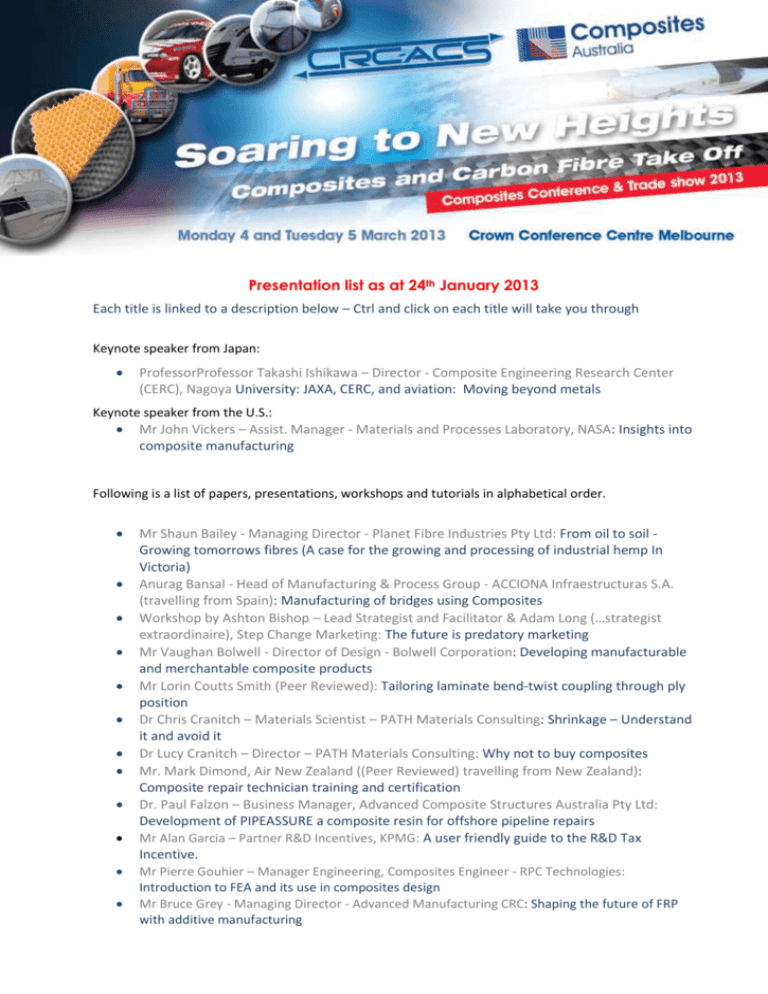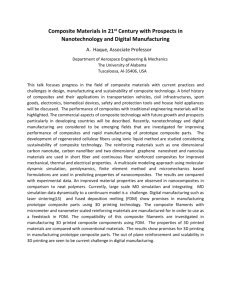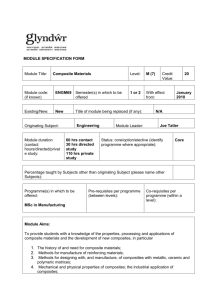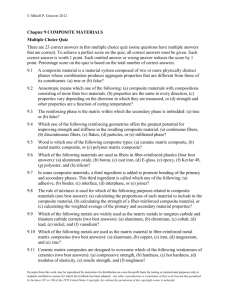noimagesummary22jan
advertisement

Presentation list as at 24th January 2013 Each title is linked to a description below – Ctrl and click on each title will take you through Keynote speaker from Japan: ProfessorProfessor Takashi Ishikawa – Director - Composite Engineering Research Center (CERC), Nagoya University: JAXA, CERC, and aviation: Moving beyond metals Keynote speaker from the U.S.: Mr John Vickers – Assist. Manager - Materials and Processes Laboratory, NASA: Insights into composite manufacturing Following is a list of papers, presentations, workshops and tutorials in alphabetical order. Mr Shaun Bailey - Managing Director - Planet Fibre Industries Pty Ltd: From oil to soil Growing tomorrows fibres (A case for the growing and processing of industrial hemp In Victoria) Anurag Bansal - Head of Manufacturing & Process Group - ACCIONA Infraestructuras S.A. (travelling from Spain): Manufacturing of bridges using Composites Workshop by Ashton Bishop – Lead Strategist and Facilitator & Adam Long (…strategist extraordinaire), Step Change Marketing: The future is predatory marketing Mr Vaughan Bolwell - Director of Design - Bolwell Corporation: Developing manufacturable and merchantable composite products Mr Lorin Coutts Smith (Peer Reviewed): Tailoring laminate bend-twist coupling through ply position Dr Chris Cranitch – Materials Scientist – PATH Materials Consulting: Shrinkage – Understand it and avoid it Dr Lucy Cranitch – Director – PATH Materials Consulting: Why not to buy composites Mr. Mark Dimond, Air New Zealand ((Peer Reviewed) travelling from New Zealand): Composite repair technician training and certification Dr. Paul Falzon – Business Manager, Advanced Composite Structures Australia Pty Ltd: Development of PIPEASSURE a composite resin for offshore pipeline repairs Mr Alan Garcia – Partner R&D Incentives, KPMG: A user friendly guide to the R&D Tax Incentive. Mr Pierre Gouhier – Manager Engineering, Composites Engineer - RPC Technologies: Introduction to FEA and its use in composites design Mr Bruce Grey - Managing Director - Advanced Manufacturing CRC: Shaping the future of FRP with additive manufacturing Dr Rik Heslehurst: Senior Lecturer/SQNLDR (RAAF Reserve), School of Engineering & Information Technology University College, UNSW: The art and science of bonding composite materials Dr Rik Heslehurst: Senior Lecturer/SQNLDR (RAAF Reserve), School of Engineering & Information Technology University College, UNSW: The effect of resin flow additives on the mechanical properties of vacuum infused composites Dr Martin Jones - Intellectual Property and Quality Manager, Advanced Composite Structures Australia Pty Ltd: Using incentive schemes to fund your company’s initiatives - A guide for 2013 Dr Dr A. A. Khatibi, S. Agius, C. Wang and M. Dingle (Peer Reviewed): Damage detection techniques for geometrically complex composite structures Ms Susan Lake and Tim Smyth - Core Builders Composites: Use of CNC in the manufacture of composite parts and tooling Chengjun Liu, Y.X. Zhang, Qinghua Qin and Rikard Heslehurst (Peer Reviewed): Numerical modelling of glass fibre metal laminates subjected to high velocity impact Mr Phil Maxwell - Group Tech. Manager - Composite Materials Engineering (CME): Composites in the solar industry Dr Menghe (Malcolm) Miao – Prinicpal Scientist – CSIRO Materials Science and Engineering: Improving carbon nanotube alignment in nanocomposites Mr. Frank Mizzi - Technical Manager - Nuplex Composites: Use of fibre reinforced polymer linings for controlling corrosion in mineral and chemical processing industries Mr. Richard Paynting, Director and Ms Leah Paff, Innovation and Industry Engagement Manager: Pre empting the market Ms Tanya Redfern - DIAB Group: Creating new opportunities through composites engineering Sindu Satasivam, Yu Bai, Xiao-Ling Zhao, Department of Civil Engineering, Monash University, (Peer Reviewed): GFRP, composite action, sandwich structure Mr Tony Stanton – Asia Pacific Engineering Manager – Gurit: The use of composites in fire resistant-critical applications Tan Minh Le and K.L. Pickering (Peer Reviewed): The mechanical properties of epoxy based hybrid biocomposites reinforced with harakeke and hemp fibres Wendland, B and Gries, T ((Peer Reviewed) travelling from Germany): 3D weaving for large scale composite production on conventional narrow looms Mr Shaun Bailey - Managing Director - Planet Fibre Industries Pty Ltd From oil to soil - Growing tomorrows fibres (A case for the growing and processing of industrial hemp In Victoria) The ‘decarbonisation’ of the transport system is also driving the need for lighter and more recyclable vehicles. Because of its technical characteristics of length and strength industrial hemp is a natural solution for the composite industry. Industrial hemp fibre reinforced plastics show considerable energy and greenhouse gas (GHG) savings, in comparison to their fossil based counterparts. Mr Bailey will present the case for developing an industrial hemp processing industry in Victoria. Anurag Bansal - Head of Manufacturing & Process Group - ACCIONA Infraestructuras S.A. Manufacturing of bridges using Composites 2 The different manufacturing processes for composite bridges are largely dictated by client needs, intent on providing simple installation, and the ideal surface finish for final users. Anurag Bansal will present the processes used to create two award-winning Spanish pedestrian bridges: The Almuñecar bridge, which employed resin infusion technology, and the Cuenca bridge, manufactured using carbon fibre pre-stressed cables as the load bearing member. This was a first in composite history for a structure of this type - at 216 metres long with three equal spans of 72 metres - made using CFRP pre-stressed cables. Workshop by Ashton Bishop – Lead Strategist and Facilitator & Adam Long (…strategist extraordinaire), Step Change Marketing The future is predatory marketing We know the applications for fibre composites are limitless, however we’re often in a position of defending FRP technology against traditional materials in the process of pitching for business. Predatory Marketing is a new method of convincing a client. It's about standing out and being chosen above competing products, processes and countries for manufacturing. ‘Step Change’ takes you on a myth-busting ride through 'giant slaying, marketing style’, and will leave you in no doubt that the future is predatory. We'll even give you tangible and practical tools to survive. Mr Vaughan Bolwell - Director of Design - Bolwell Corporation Developing manufacturable and merchantable composite products In 2010 the Victorian company ‘Bolwell Corporation’ utilised its industrial design and engineering team’s expertise in advanced composites and invested in tooling to develop a fully moulded composites-based touring caravan, complete with lightweight, aerodynamic properties. This marked the Bolwell Company’s 50th year in transport innovation using composite technology. Vaughan Bolwell will speak on successfully designing using composites for lucrative manufacturable and merchantable outputs. Mr Lorin Coutts Smith (Peer Reviewed) Tailoring laminate bend-twist coupling through ply position The use of unbalanced symmetrical or unsymmetrical laminates is often avoided due to complex and undesirable structural behaviour, such as warping and twisting resulting from material elastic couplings. However, in fields such as aerodynamics, tailored elastic coupling can be exploited to achieve performance gains via ‘aeroelasticity’. This research explores bend-twist coupling and structural response in thin laminated cantilever beams subject to transverse loads (with a focus on ‘through thickness ply position’ effects). Lorin Coutts Smith will present the findings. Dr Chris Cranitch – Materials Scientist – PATH Materials Consulting Shrinkage – Understand it and avoid it Shrinkage plagues composite manufacture, whether producing aerospace components, chemical tanks, car parts, or even playground equipment. When shrinkage is excessive parts can warp, crack, print, prerelease, or fail. However, interesting concepts and technologies can be utilised to combat the problem. Dr Chris Cranitch will describe precisely what causes shrinkage and the ways it can be minimised, including low profile polyesters, matrix controlled shrinkage epoxies and by examining thermal expansion rates of parts and moulds. 3 Dr Lucy Cranitch – Director – PATH Materials Consulting Why not to buy composites Engineers and end users have frequently shown resistance to buying composite products, in preference for alternative materials such as rubber, concrete and steel. A number of major projects which span infrastructure, chemical and mining applications have been analysed to reveal exactly what these perceived hurdles were. Dr Lucy Cranitch will present her findings and engage composite industry members to discuss solutions for the greater promotion and uptake of composites. Mr. Mark Dimond, Air New Zealand ((Peer Reviewed) travelling from New Zealand) Composite repair technician training and certification Safety is the primary concern in the maintenance of aircraft. There has been a rapid growth of composites used in both commercial and military aircraft. Mark Dimond will break down the regulatory data and reports to date concerning the control and repair of aircraft built with composite components. Mr Dimond will also examine recent aircraft incidents, and those relevant areas of composite repair technician training and certification. Dr. Paul Falzon – Business Manager, Advanced Composite Structures Australia Pty Ltd Development of PIPEASSURE a composite resin for offshore pipeline repairs To solve the considerable challenge of corrosion and other damage sustained by piping, pipelines and risers, widely used in the oil and gas industry, a new glass/epoxy prepreg system has been developed. Applicable for dry, wet and fully submerged underwater conditions this is highly effective for both rehabilitation and corrosion protection of steel infrastructure. Paul Falzon will present the mechanical, hydrostatic and corrosion protection testing undertaken to validate the system, and outline a new carbon fibre reinforced version. Mr Alan Garcia – Partner R&D Incentives, KPMG A user friendly guide to the R&D Tax Incentive The Research & Development Tax Incentive is described by the government as a targeted, generous and easy to access entitlement program that helps businesses offset some of the costs of doing R&D. The program is designed to help businesses undertake R&D and to innovate, all of which will assist bringing new products, processes and manufacturing advances into the Australian market place. Alan’s presentation will demystify the complexities of the R&D Tax Incentive program and explain how it applies to firms that make things. Mr Pierre Gouhier – Manager Engineering, Composites Engineer - RPC Technologies Introduction to FEA and its use in composites design Nowadays Finite Elements Analysis (FEA) is a more commonly used engineering tool that is critical to the reliable design and engineering of composites structure. This presentation provides a practical introduction to FEA by explaining the general processes and vocabulary used, as well as referring to some specifics of composites design. Pierre Gouhier will also describe how FEA can support the effective engineering of composites structures as they relate to final manufactured goods. 4 Mr Bruce Grey - Managing Director - Advanced Manufacturing CRC Shaping the future of FRP with additive manufacturing Additive manufacturing (or 3D printing) is a process of making three dimensional solid objects from a virtual design or digital model using additive processes of successively layering material to form a dimensional shape. This technology is progressively challenging traditional machining techniques that rely on the removal of material by methods such as cutting and drilling. Mr Grey will outline the additive manufacturing technologies that will change the future of product design and development and accelerate the accuracy and process by which moulds are made for fibre-reinforced polymers. Dr Rik Heslehurst: Senior Lecturer/SQNLDR (RAAF Reserve), School of Engineering & Information Technology University College, UNSW The art and science of bonding composite materials When joining composite structures there is the general option to ‘bolt’ or ‘bond’. Factors which drive this decision are structural thickness, materials being used (glass, aramid, carbon, etc.), fibre orientation and stiffness, environmental factors, loads and more. Bonding involves the complex science of adhesive joint design. Dr Heslehurst will delve into the detailed and evolving design issues that ultimately determine successful joint design and fabrication. Of central importance, ply layup configuration, peel and taper arrangement. Dr Rik Heslehurst: Senior Lecturer/SQNLDR (RAAF Reserve), School of Engineering & Information Technology University College, UNSW The effect of resin flow additives on the mechanical properties of vacuum infused composites For both end-user and fabrication requirements additives are often added to resin systems. In processes such as ‘Vacuum Infusion’ solvent is added to improve resin infusion rates. Also, fire and smoke inhibiting agents may be added to resin to meet specific certification authority regulations. In this investigation both an additive and solvent were separately added to a resin mix for infusion into a glass fibre composite, via vacuum assistance. Rikard Heslehurst will present the findings. Keynote speaker from Japan: Professor Takashi Ishikawa – Director - Composite Engineering Research Center (CERC), Nagoya University JAXA, CERC, and aviation: Moving beyond metals Dr Takashi Ishikawa of the Composite Engineering Research Center (CERC) based in Nagoya University, Japan directs a team which investigates advanced composites and their capabilities. Recent developments for Boeing have included the application of carbon fibre reinforced plastic (CFRP) in aircraft. Exceptionally strong and lightweight, additional benefits are derived creating a cabin of largely non-corrosive material, where humidity levels may be elevated for passengers. Dr Takashi will present on the outcomes of recent CERC research for Japanese and international aviation, and particular methods used in the development of these breakthrough CFRP’s. Dr Martin Jones - Intellectual Property and Quality Manager, Advanced Composite Structures Australia Pty Ltd Using incentive schemes to fund your company’s initiatives - A guide for 2013 5 State government vouchers, enterprise connect incentives and the core federal R&D Tax Credit are among the wide range of incentives that can be leveraged by composites companies to make a significant improvement to their bottom line. Incentives can help a company achieve key objectives, while reducing or even eliminating the investment made. Unfortunately, each incentive has different eligibility and entitlement rules. Mr Jones will suggest ‘adopting’ an incentive to do what the organisation had planned to do anyway - modifying the business plan just enough to meet the criteria. Dr A. A. Khatibi, S. Agius, C. Wang and M. Dingle (Peer Reviewed) Damage detection techniques for geometrically complex composite structures Traditional non-destructive evaluation (NDE) methods used to characterise materials and inspect products are visual, operator-dependent, and subjective - often slow and imprecise. New methods use automated, digital techniques such as digital radiography and computed tomography, which can be manipulated for computational analysis. Dr Khatibi presents an experimental study on NDE methods for complex shaped composite structures - such as vehicle composite wheels - using a novel Laser Scanning Vibrometery (LSV) technique, for high-speed identification of manufacturing defects and service damage. This paper investigates the capability and sensitivity of LSV. Ms Susan Lake and Tim Smyth - Core Builders Composites Use of CNC in the manufacture of composite parts and tooling Core Builders Composites have been highly successful in their approach to integrated Computer Numerically Controlled (CNC) technology, used to manufacture tooling for composite parts used in boatbuilding. In 2012 Core successfully built 10 identical 45’ wing-sailed catamarans in a single year and is currently building the AC72 catamarans that will defend the America’s Cup in 2013. Susan Lake will present the integrated use of CNC technology. Also, the key features of tooling used for ambient out-ofautoclave and autoclave composite curing. The primary goal has been to maximise the efficiencies possible for the manufacture of composite parts. Chengjun Liu, Y.X. Zhang, Qinghua Qin and Rikard Heslehurst (Peer Reviewed) Numerical modelling of glass fibre metal laminates subjected to high velocity impact As a type of fibre metal laminate, ‘glass fibre metal’ laminates (GLAREs) exhibit superior properties to conventional lamina, and to monolithic aluminium alloys. - GLARE is extensively used in the aviation industry due to its light-weight and impact resistant qualities. Chengjun Liu presents the finite element model (FEM), or numerical model, developed to predict dynamic behaviour of a GLARE beam under high velocity impact (HVI). (Validated against a FEM created for basic ‘glass fibre composite’ lamina only). The FEM for GLARE can computationally predict HVI results well, and may be suitable for investigating impact on different composite laminates, as well as different GLAREs. Mr Phil Maxwell - Group Tech. Manager - Composite Materials Engineering (CME) Composites in the solar industry The explosion of alternative energy generation in Australian homes has been satisfied by fixed photovoltaic and heat absorbing panels. CME has been working with an Australian company to develop an electricity / hot water cogeneration system that combines these functions in one package. The core of this technology is solar cells bonded to a heat exchanger that generates electricity, while the waste heat is used to produce hot water. Phil Maxwell will outline this system, also able to track the sun, and the potential for successful manufacture in Australia. 6 Dr Menghe (Malcolm) Miao – Prinicpal Scientist – CSIRO Materials Science and Engineering Improving carbon nanotube alignment in nanocomposites There are significant challenges in scaling up carbon nanotubes (CNTs) into larger structures (macroscopic structures) that express the same, or similar, qualities of bonding strength suitable for fibres/textiles. Proven techniques are by twisting or using solvent to give ‘aligned’ CNTs density and strength. The first step, traditionally, has been to mobilise or break apart the tiny CNTs so they can then be appropriately aligned. Dr Menghe will present a different method, which uses a lubricant to more gently loosen the CNTs, followed by a drawing out operation which slides them into superior longitudinal alignment, to enhance strength. Mr. Frank Mizzi - Technical Manager - Nuplex Composites Use of fibre reinforced polymer linings for controlling corrosion in mineral and chemical processing industries Fibre reinforced (FRP) epoxy vinyl ester resin demonstrates excellent chemical resistance. When applied as a protective lining for highly corrosive materials of construction, such as steel and concrete (commonly found in tanks, process vessels and piping) this material requires minimal maintenance over the life of the equipment. As an alternative to rubber lining fibre reinforced epoxy vinyl ester resin is also simple to apply. Frank Mizzi will explain how selecting the appropriate resin is fundamental to liner performance, and how outstanding abrasion resistance can be achieved through various additives during the formulation stage. Mr. Richard Paynting, Director and Ms Leah Paff, Innovation and Industry Engagement Manager Advanced Manufacturing CRC Pre empting the market INNOVATIVITY® is a real-world innovation management training program developed by the Advanced Manufacturing Cooperative Research Centre (AMCRC) to provide Australian organisations with the skills and tools to grow profit and reach global markets through innovation. AMCRC has extensive experience in backing high tech, IP based projects providing you with real insight into what Australian companies really need to commercialise technology. AMCRC doesn't just teach innovation, it backs its own projects. Funding and commercialising Australian IP is their core business real Innovators telling real stories about real experiences around products and services in the real world. This two hour workshop will give you insight into one of the learning areas of the 3 day program – “Pre-empting the Market” which provides your business the tools to develop and apply a formal process to planning the next generation of novel products and processes. Ms Tanya Redfern - DIAB Group Creating new opportunities through composites engineering Many new markets are opening up to the use of composites. However, it can be daunting to approach an opportunity when composites are unfamiliar to stakeholders. Different terminology, unknown Standards, cost structures and networks create unfamiliar territory for the composites fabricator. Tanya Redfern will describe the active role DIAB has played in approaching new potential market segments. The DIAB vision is to provide increased opportunities for composite fabricators by actively familiarising potential new end-users with the versatility and durability of composite materials. This presentation provides an overview of avenues to entry, feedback and learnings, gleaned from DIAB’s global experience. 7 Sindu Satasivam, Yu Bai, Xiao-Ling Zhao, Department of Civil Engineering, Monash University, (Peer Reviewed) GFRP, composite action, sandwich structure Fibre Reinforced Polymer (FRP) composites are increasingly being used in structural engineering due to their high strength, low weight and resistance to corrosion. This paper describes an innovative modular assembly system of FRP sandwich structures used for beams and slabs in building construction. Sindu Satasivam presents the findings, and explains the potential prefabrication and rapid onsite installation, now possible. Mr Tony Stanton – Asia Pacific Engineering Manager – Gurit The use of composites in fire resistant-critical applications Despite the stringent fire requirements that apply to architecture, infrastructure, public transport and more, the relevant regulations have, generally, not been designed with composite materials in mind. Gurit has been involved in many projects where fire resistance has been a key objective, and has carried out a number of in-house and project-specific research initiatives to examine optimal approaches for tackling these challenges. Mr Stanton will provide an overview of the issues, plus a number of case studies from different market sectors which highlight particular areas to be addressed for fire safety and compliance. Tan Minh Le and K.L. Pickering (Peer Reviewed) The mechanical properties of epoxy based hybrid biocomposites reinforced with harakeke and hemp fibres Harakeke is the Maori name for the New Zealand native plant commonly known as New Zealand flax. Long fibre extracted from harakeke leaves has an extensive history, used in the production of clothes, sacking and rope. Now harakeke is being investigated for use in composites. For this research Tan Minh Le explains how the harakeke fibre was hybridised with hemp fibre in epoxy resin. Hybrid composites with different layering patterns were prepared using hand lay-up, followed by compression moulding, to evaluate the full range of strength and flexibility. Keynote speaker from the U.S.: Mr John Vickers – Assist. Manager - Materials and Processes Laboratory, NASA Insights into Composite Manufacturing Cutting-edge ‘óut-of-autoclave’ technology, developed for composite curing during manufacture, has been utilised by NASA as they seek new methods to reduce the weight and cost of launch vehicles used in space exploration. Through the ‘Composite Cryotank’ project John Vickers engineered a cryotank spanning almost 10 metres in diameter for storing super-cold fuels. Mr Vickers will explain parallel developments in both cryotank and out-of-autoclave technologies, further opening up the US aerospace industry, along with new areas of renewable energy manufacture, to small business. Wendland, B and Gries, T ((Peer Reviewed) travelling from Germany) 3D weaving for large scale composite production on conventional narrow looms 3D woven fabrics are about to shift from niche markets to large scale applications. For example, Airbus will be using 3D woven carbon turbine blades in new LEAP engines for the A320neo. Due to the complex ‘weave architecture’ these fabrics require careful testing. Benedikt Wendland will present the 8 dependencies evident between weaving parameters and impact properties, along with a cost calculation tool which is programmed to compare conventional prepreg to 3D woven and RTMimpregnated parts. 9





